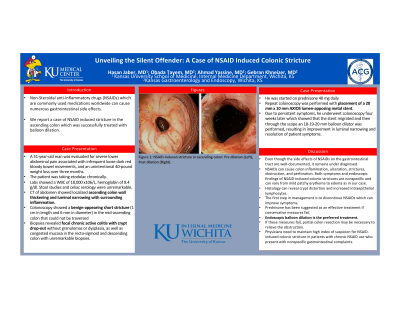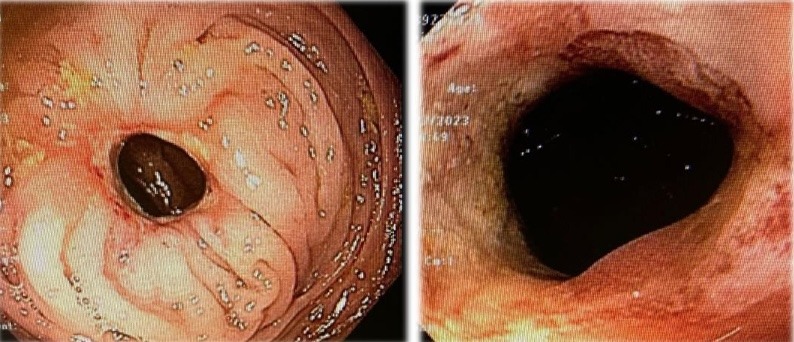Sunday Poster Session
Category: Colon
P0351 - Unveiling the Silent Offender: A Case of NSAID-Induced Colonic Stricture
Sunday, October 27, 2024
3:30 PM - 7:00 PM ET
Location: Exhibit Hall E

Has Audio
- HJ
Hasan Jaber, MD
University of Kansas School of Medicine
Wichita, KS
Presenting Author(s)
Hasan Jaber, MD1, Obada Tayyem, MD2, Ahmad Yassine, MD2, Gebran Khneizer, MD2
1University of Kansas School of Medicine, Wichita, KS; 2Kansas Gastroenterology and Endoscopy, LLC, Wichita, KS
Introduction: Non-Steroidal anti-inflammatory drugs (NSAIDs) which are commonly used medications worldwide can cause numerous gastrointestinal side effects. We report a case of NSAID induced stricture in the ascending colon which was successfully treated with balloon dilation.
Case Description/Methods: A 51-year-old man was evaluated for severe lower abdominal pain associated with infrequent loose dark red bloody bowel movements, and an unintentional 40-pound weight loss over three months. The patient was taking etodolac chronically. Labs showed a WBC of 18,000 x106/L, hemoglobin of 8.4 g/dl. Stool studies and celiac serology were unremarkable, and CT of abdomen showed localized ascending colon wall thickening and luminal narrowing with surrounding inflammation. Colonoscopy showed a benign-appearing short stricture (1 cm in length and 6 mm in diameter) in the mid-ascending colon that could not be traversed, with biopsies revealing focal chronic active colitis with crypt drop-out without granulomas or dysplasia, as well as congested mucosa in the recto-sigmoid and descending colon with unremarkable biopsies. He was started on prednisone 40 mg daily and a repeat colonoscopy was performed with placement of a 20 mm x 10 mm AXIOS lumen-apposing metal stent. Due to persistent symptoms, he underwent colonoscopy four weeks later which showed that the stent migrated and then through the scope an 18-19-20 mm balloon dilator was performed, resulting in improvement in luminal narrowing and resolution of patient symptoms.
Discussion: Even though the side effects of NSAIDs on the gastrointestinal tract are well-documented, it remains under diagnosed. NSAIDs can cause colon inflammation, ulceration, strictures, obstruction, and perforation. Both symptoms and endoscopic findings of NSAID-induced colonic strictures are nonspecific and can vary from mild patchy erythema to edema as in our case. Histology can reveal crypt distortion and increased intraepithelial lymphocytes. The first step in management is to discontinue NSAIDs which can improve symptoms. Prednisone has been suggested as an effective treatment if conservative measures fail. Endoscopic balloon dilation is the preferred treatment. If these measures fail, partial colon resection may be necessary to relieve the obstruction.
Physicians need to maintain high index of suspicion for NSAID-induced colonic stricture in patients with chronic NSAID use who present with nonspecific gastrointestinal complaints.

Disclosures:
Hasan Jaber, MD1, Obada Tayyem, MD2, Ahmad Yassine, MD2, Gebran Khneizer, MD2. P0351 - Unveiling the Silent Offender: A Case of NSAID-Induced Colonic Stricture, ACG 2024 Annual Scientific Meeting Abstracts. Philadelphia, PA: American College of Gastroenterology.
1University of Kansas School of Medicine, Wichita, KS; 2Kansas Gastroenterology and Endoscopy, LLC, Wichita, KS
Introduction: Non-Steroidal anti-inflammatory drugs (NSAIDs) which are commonly used medications worldwide can cause numerous gastrointestinal side effects. We report a case of NSAID induced stricture in the ascending colon which was successfully treated with balloon dilation.
Case Description/Methods: A 51-year-old man was evaluated for severe lower abdominal pain associated with infrequent loose dark red bloody bowel movements, and an unintentional 40-pound weight loss over three months. The patient was taking etodolac chronically. Labs showed a WBC of 18,000 x106/L, hemoglobin of 8.4 g/dl. Stool studies and celiac serology were unremarkable, and CT of abdomen showed localized ascending colon wall thickening and luminal narrowing with surrounding inflammation. Colonoscopy showed a benign-appearing short stricture (1 cm in length and 6 mm in diameter) in the mid-ascending colon that could not be traversed, with biopsies revealing focal chronic active colitis with crypt drop-out without granulomas or dysplasia, as well as congested mucosa in the recto-sigmoid and descending colon with unremarkable biopsies. He was started on prednisone 40 mg daily and a repeat colonoscopy was performed with placement of a 20 mm x 10 mm AXIOS lumen-apposing metal stent. Due to persistent symptoms, he underwent colonoscopy four weeks later which showed that the stent migrated and then through the scope an 18-19-20 mm balloon dilator was performed, resulting in improvement in luminal narrowing and resolution of patient symptoms.
Discussion: Even though the side effects of NSAIDs on the gastrointestinal tract are well-documented, it remains under diagnosed. NSAIDs can cause colon inflammation, ulceration, strictures, obstruction, and perforation. Both symptoms and endoscopic findings of NSAID-induced colonic strictures are nonspecific and can vary from mild patchy erythema to edema as in our case. Histology can reveal crypt distortion and increased intraepithelial lymphocytes. The first step in management is to discontinue NSAIDs which can improve symptoms. Prednisone has been suggested as an effective treatment if conservative measures fail. Endoscopic balloon dilation is the preferred treatment. If these measures fail, partial colon resection may be necessary to relieve the obstruction.
Physicians need to maintain high index of suspicion for NSAID-induced colonic stricture in patients with chronic NSAID use who present with nonspecific gastrointestinal complaints.

Figure: Figure 1: NSAID-induced stricture in ascending colon: Pre dilation (Left), Post dilation (Right).
Disclosures:
Hasan Jaber indicated no relevant financial relationships.
Obada Tayyem indicated no relevant financial relationships.
Ahmad Yassine indicated no relevant financial relationships.
Gebran Khneizer indicated no relevant financial relationships.
Hasan Jaber, MD1, Obada Tayyem, MD2, Ahmad Yassine, MD2, Gebran Khneizer, MD2. P0351 - Unveiling the Silent Offender: A Case of NSAID-Induced Colonic Stricture, ACG 2024 Annual Scientific Meeting Abstracts. Philadelphia, PA: American College of Gastroenterology.
